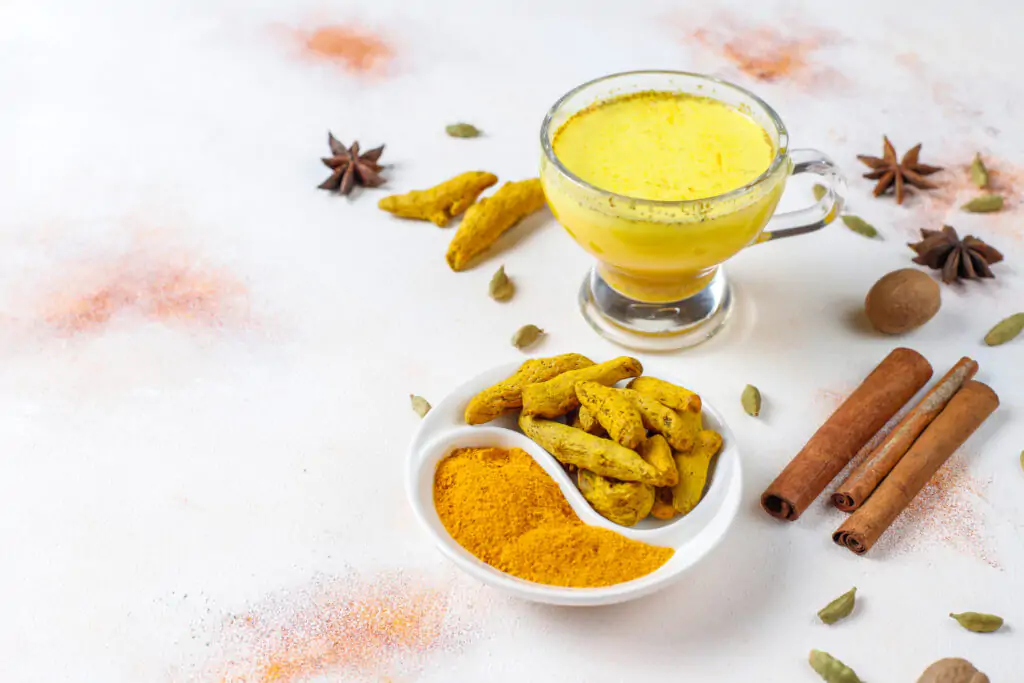Introduction
Curcuma longa roots contain curcumin, the primary bioactive component of turmeric. Curcumin is a polyphenol. Anticancer, antioxidant, anti-inflammatory, anti-obesity, anti-diabetic, anti-microbial, wound-healing, and lipid-lowering qualities are just a few of the many health advantages of this chemical.
Following intestinal absorption, curcumin is quickly transformed into a variety of bioactive metabolites with poor bioavailability in human organs. Between two and five percent of curcumin may be found in dried turmeric powder made from Curcuma longa roots.
Dietary sources of curcumin provide enough of it to affect the gut microbiota. However, as seen in in vitro experiments with cultured cells, the fast metabolism causes the concentration of intact curcumin in the blood to drop to extremely low levels (sub-micromolar concentrations), which is inadequate to initiate cellular signalling and gene activation.
Methods to improve the bioavailability of curcumin
Dietary curcumin is quickly metabolised and eliminated from the body after being ineffectively absorbed by the intestinal epithelium. Curcumin’s stability is decreased when it forms the enol state in an aqueous solution with a pH value of zero.
A number of nanoformulations have been created to raise the concentration of curcumin in certain cells, tissues, and organelles, as well as in the bloodstream. With the use of adjuvants, these nanoformulations have been created to modify absorption pathways, boost curcumin solubility, improve stability throughout intestinal absorption, and inhibit detoxification enzymes.
The most recent curcumin nanoformulations have the capacity to boost absorption, cellular uptake, permeability through the blood-brain barrier, and tissue distribution while also increasing free curcumin bioavailability in plasma by more than 100 times.
Curcumin bioavailability is improved with the size, content, and mode of ingestion of nanoparticles. Oral administration of curcumin formulations utilising smaller-sized nanoparticles has been proven to boost bioavailability. On the other side, when given intravenously, bigger-size nanoparticles are believed to improve bioavailability.
Numerous cancer kinds, as well as age-related ailments including brain, liver, lung, and gastrointestinal issues, as well as tumours of the cardiometabolic and normal cell lines, have all been effectively treated using curcumin nanotechnology.
On the basis of how it works, the research to date shows that curcumin functions as an anti-inflammatory and antioxidant ingredient to lower the generation of reactive oxygen species (ROS) and alter gene expression and cellular signalling associated with inflammatory pathways. Together, these processes keep cellular macromolecules (proteins, DNA, and lipids) in a state of homeostasis.
Curcumin can be added to formulations containing nanoparticles, such as polymeric curcumin-bioperine-PLGA, in order to improve these benefits. It is commonly recognised that curcumin isomerizes into cis-trans curcumin, which increases its affinity for adenosine receptors. The anti-inflammatory effects of cis-trans curcumin can be improved simply by including it into nanoformulations.
In terms of safety profile, most curcumin nanoformulations are safe and well-tolerated for human usage, according to recent clinical investigations.
Anti-microbial activities
Gram-positive and Gram-negative bacteria are known to be susceptible to curcumin’s anti-microbial action, which makes it useful for topical treatments against skin infections as well as oral and intestinal uses. Additionally, curcumin can ward off illness indirectly by preventing the development of germs in meals.
In order to improve its antibacterial qualities, curcumin can be utilised in nanoformulations. Using curcumin with honey, antibiotics, or other kinds of polyphenols might improve its anti-microbial and biofilm-inhibiting abilities.
Impact of gastrointestinal tract curcumin nanoformulations
Oral curcumin bioavailability has been reported to be enhanced by a number of nanotechnology-based systems, including micelles, liposomes, exosomes, phospholipid complexes, nanoemulsions, nanostructured lipid carriers, and biopolymer nanoparticles.
It has been found that by altering the intestinal flora of mice, the curcumin nanoparticle dubbed “Theracurmin” inhibits colitis. Enhancing the composition of the gut flora has also been accomplished by the extraction of curcumin from nanobubbles. It has been found that in animal colons, curcumin coated with nanostructured lipid carriers decreases inflammation.
Curcumin has been found to increase the anticancer activity of liposomes by improving gastrointestinal absorption. Furthermore, it has been shown that combining curcumin with salsalate and piperine increases both its bioavailability and bioactivity.
Curcumin nanoformulations' effects on adipose and liver tissue
It has been discovered that curcumin nanoformulations with adjuvants such as piperine and quercetin greatly boost the drug’s bioavailability and bioactivity. It has been demonstrated that curcumin bioavailability may be increased by a number of nanotechnology-based delivery systems, including solid lipid nanoparticles, liposomes, polymeric nanoparticles, and metal nanoparticles.
Because of its antioxidant, anti-inflammatory, and antifibrotic characteristics, curcumin is a possibly effective medication for liver diseases. Curcumin nanoformulations have been shown to enhance the drug’s solubility, bioavailability, and membrane permeability in liver illnesses, along with enhancing the drug’s pharmacokinetics, pharmacodynamics, and biological distribution.
Effects of curcumin nanoformulations on the cardiovascular system
It has been discovered that curcumin’s cardiac bioavailability is increased when it is encapsulated in carboxymethyl chitosan nanoparticles linked to a myocyte-specific homing peptide. Additionally, it has been shown that the formulation enhances heart function by lowering the expression of genes associated with hypertrophy and apoptotic mediators.
Numerous curcumin nanoformulations have been discovered to improve curcumin’s water solubility and therefore reduce hypertension in animals. This includes hyaluronic acid-based nanocapsules, nanoparticles enclosed in PLGA, and nanoemulsion systems. It has been shown that nisin-curcumin-containing polylactic acid nanoparticles and nanocurcumin polymer-based nanoparticles exhibit cardioprotective properties. Certain combinations have been found in studies to help minimise myocardial dysfunction and enhance cardiac function.
Curcumin nanoformulations' effects on the brain
It has been shown that curcumin complexed with galactomannans exhibits improved permeability of the blood-brain barrier and greater effectiveness in reducing neuroinflammation, anxiety, exhaustion, and memory loss in both people and animals.
It has been discovered that curcumin-loaded liposomes have anti-inflammatory and anti-amyloidogenic characteristics in cellular and animal models of Alzheimer’s disease. Due to curcumin’s capacity to inhibit tau aggregation and amyloid-beta development, two of the primary signs of Alzheimer’s disease, the illness may be prevented.
However, curcumin did not appear to have any positive effects on disease biomarkers or cognitive performance in clinical trials, including individuals with mild to severe Alzheimer’s disease.
Conversely, a recent clinical experiment including individuals without dementia has demonstrated that therapy with oral curcumin can enhance memory and decrease the build-up of tau and amyloid in the hypothalamus and amygdala.
Conclusion
Scientists are using nanotechnology to boost curcumin’s bioavailability and effectiveness in in order to optimise its health benefits. Curcumin’s low absorption and fast metabolism have been overcome by developing a number of nanoformulations, namely liposomes, nanoemulsions, and polymeric nanoparticles. These advancements have not only advanced the transport of curcumin to target tissues and organs but have additionally expanded its healing ability in treating a wide variety of conditions, consisting of most cancers, inflammation, microbial infections, and neurodegenerative illnesses.
The combination of curcumin with nanoparticles gives very amazing new possibilities for boosting human fitness and well-being. Although further study is required to fully comprehend the processes and decorate formulations, current evidence indicates the potential of curcumin nanoformulations as a beneficial tool in therapeutic and preventive medicine.
FAQ's
Q: What are curcumin nanoformulations?
A: Curcumin nanoformulations are present day transport systems that lease nanoparticles to enhance the bioavailability and efficacy of curcumin, the number one bioactive compound in turmeric. These nanoformulations aim to conquer the regulations of curcumin’s lousy absorption and speedy metabolism, thereby increasing its recuperation functionality.
Q: What health benefits do curcumin nanoformulations offer?
A: Curcumin nanoformulations provide an extensive variety of health benefits, including anti-inflammatory, antioxidant, anti-most cancer, anti-microbial, and neuroprotective properties. By enhancing the delivery and focus of curcumin to particular tissues and organs, nanoformulations have shown promise in treating numerous situations, consisting of most cancers, irritation, microbial infections, and neurodegenerative illnesses.
Q: Are curcumin nanoformulations safe for human consumption?
A: Most curcumin nanoformulations have been discovered to be secure and properly tolerated for human use, according to current medical investigations. However, as with all complements or remedies, it’s far more beneficial to visit a healthcare professional before incorporating curcumin nanoformulations into your routine, especially if you have underlying health situations or are taking medicines.




